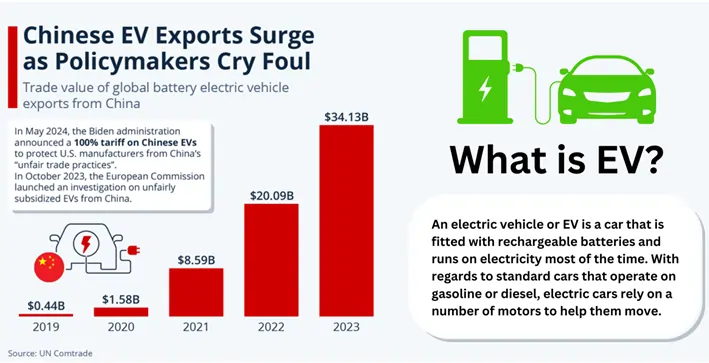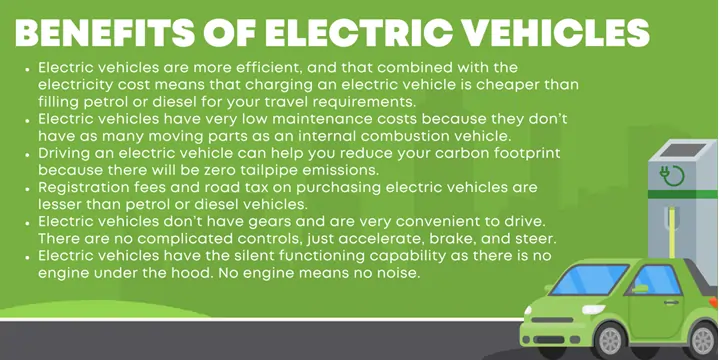India should avoid becoming a "colony of electric vehicles (EVs)" for China and chart its own path in the global electric vehicle landscape, according to a recent report published by trade policy think tank Global Trade Research Initiative (GTRI).
Highlights of the report published by GTRI

China's dominance in the global EV market in 2023 and resistance from Western countries:
- In 2023, China exported 1.6 million electric vehicles, worth a total of US$36.7 billion. The European Union (EU) and the United States (US) were the major importers, with the EU importing US$19.5 billion worth of EV parts and US$9.1 billion worth of EVs. The United States imported $10.4 billion worth of EV parts and $357 million worth of EVs, $19 billion worth of batteries, $13.8 billion worth of hybrid EVs and plug-in hybrid EVs.
- China has established itself as the largest producer and exporter of EVs through the use of subsidies and control over battery raw materials. After which Chinese companies began to replace the local production of these countries.
- This led to the US, EU and Canada imposing additional duties and bans on EVs and parts imported from China. In May 2024, the US has increased duties on Chinese EVs from 25% to 100%. The EU and Canada have also announced plans to impose additional duties on Chinese EVs.
- The US is investigating Chinese EV manufacturers for "dumping" in the US market. If found guilty, companies may be imposed additional penalties. In addition, the US has also imposed restrictions on Chinese investment in domestic EV companies, while the EU has imposed anti-subsidy duties on Chinese EVs, citing unfair government subsidies.
- Under these circumstances, China is shifting its production and assembly units to ASEAN countries and India. These units will still depend on imports from China for 70-80% of components and batteries.
- Thailand is the is first among allowing chinese. Chinese companies such as BYD, SAIC Motor, and Great Wall Motors have set up assembly plants taking advantage of Thailand's automotive industrial infrastructure and subsidies.
The growing dominance of Chinese EV companies is raising concerns about the competitiveness and sustainability of local automotive manufacturers and suppliers. Reports suggest that demand for locally produced auto parts has declined. Some suppliers have faced a reduction in business by up to 40%.
India’s plans for global EV companies and concerns with respect to China:
- To encourage EV companies, India has reduced import duty from 70-100% to 15% on vehicles with CIF value of more than US$35,000. This concession is for OEMs who invest US$500 million in setting up plants in India.
- The Indian government is providing concessions with the aim of attracting investment and technology transfer, but at the same time providing an opportunity to Chinese companies to take unfair advantage. As can be understood from the example of Thailand.
- India has allowed major Chinese EV manufacturers to operate in India. This could lead to a flood of Chinese EVs in the Indian market in the coming years.
- A joint venture formed by China’s SAIC Motor (owner of the MG brand) and India’s JSW Group aims to sell over one million new electric vehicles by 2030. The joint venture aspires to recreate a “Maruti Suzuki-like environment” for EVs in India, potentially leading to every third EV on Indian roads being manufactured by Chinese companies.
- EV batteries and components are largely produced in China. This will further increase India’s dependence on China.
- There is also a risk of China dumping EVs in India if China loses access to developed markets.
- Given these challenges, India should allow its EV sector to develop naturally, without relying on incentives or becoming overly dependent on China.
Challenges for India in the Electric Vehicle Sector
More than 80% of electricity in India is generated from fossil fuels, which can reduce the environmental benefits of EVs. Frequent power cuts can lead to charging of batteries from diesel generators, which can further reduce the environmental benefits. EV production, especially battery manufacturing, has a high carbon footprint. Shortage and supply problems of raw materials required for batteries can further increase costs in the future. Some of the key issues are:
- Limited Model Options: Picture this: You go to an EV showroom and you realize that there are limited models that are on display for sale. While the list of conventional cars is innumerably long, there are limited players in the EV segment in India. They want more choices – the regulator size, the style or the lower price, and are willing to pay for it.
- Awareness Gap: Picture a situation where someone believes that an EV is just a golf cart with dreams of being a sports utility vehicle. Indeed, that is the awareness gap that we have to work with. The general public is thus still not aware of the advantages of EVs, which include less pollution, less noise and less reliance on the use of hydrocarbons. Closing knowledge deficits like this is imperative.
- Uneven Electricity Distribution: EVs survive on electrons and hence, their charging infrastructure is anchored on a sound electricity grid. However, all the corners of the country are not fortunate enough to have a steady power supply. They state that the cost difference must be adjusted for the EV promotion to be successful across the market.
- Charging Infrastructure Woes: Charging infrastructure serves as the backbone of any electric vehicle all over the world. There are not enough charging stations and the current ones should be established in more locations such as public places, apartment buildings and near roads.
- Service and Repair Networks: Charging points for electric cars are still limited and stations are available in very few numbers. As the number of EVs increases, there is a steady need to develop a pool of technicians who are capable of fixing, diagnosing and catering to the delicate needs of these ‘electric horses’.
Recommended EV Strategy for India
India should invest in research and development (R&D) for advanced battery technologies, such as solid-state batteries and hydrogen fuel cells. Any significant discovery can establish the country as a leader in sustainable transportation. We need a new PLI scheme, as the current PLI scheme has not delivered any commercially viable results for advanced chemistry battery production. India should invest in battery recycling infrastructure and support clean energy sources for EV charging stations. India should strengthen environmental regulations for EV manufacturing and disposal to minimize the carbon footprint and other negative impacts associated with EV production.
Electric Vehicles (EVs)
Definition: An electric vehicle or EV is a car that is fitted with rechargeable batteries and runs on electricity most of the time. With regards to standard cars that operate on gasoline or diesel, electric cars rely on a number of motors to help them move. Here are some key points about EVs:
Power Source: Electric cars do not entail fuel to run them, instead they rely on electrical energy. They then hold this energy in high density batteries, which can then be charged in different ways.On the other hand, traditional vehicles employ traditional fuel such as gasoline or diesel to power up the internal combustion engines.
Zero Emissions: Undoubtedly, this is one of the most important and profound advantages of electric vehicles, emphasizing the green side. During their operation, they emit zero levels of tailpipe emissions.ICE vehicles generate emission which has negative impacts to the environment such as CO₂, NOₓ and particulate matter.
Components: It has also been observed that ICE vehicles have more moving parts compared to EVs. These may include electric motor, power control system and battery.ICE vehicles also have the motor, gearbox, mufflers, and fuel tanks, which have a moderate level of difficulty.
Driving Experience: The first benefit of EVs is the ability to deliver torque in an instant, which is another way of providing instant acceleration as well. They are comfortable and convenient by providing a silent and non-jarring ride.ICE vehicles may feel differently when driven compared with the ME engines because they have a different cadence.
Charging Infrastructure: These cars require charging points or home chargers in order to be charged and function. Some of the charging times differ depending on the type of charger used, Level 1, Level 2 or DC fast charging.ICE vehicles, which have already been said, can always pull into gas stations that are denser globally.

How EVs Work:
Battery and Electric Motor: EVs use lithium-ion or any other form of the advanced battery system to store energy in their respective cars. These are batteries which are going to be connected to an electric motor which in turn is going to make the wheels move.The motor acquires electric current via the accelerator pedal from the battery and transforms the current into mechanical energy to power the automobile.EVs benefit from features like regenerative braking to capture energy used during episodes of deceleration. When you move your foot off the gas pedal or apply the brake, the motor turns into a generator and converts back the kinetic energy to electricity. This energy is then stored in the battery for better efficiency of the energy produced and being used.
Charging Methods
EVs can be charged using different methods:
- Level 1 Charging: It is connected to a standard household electrical outlet, in this case 110 Volts. Relatively time consuming but ideal when charging a battery overnight.
- Level 2 Charging: It has a constant 240V charging point reunion that must be located. Faster than Level 1.
- DC Fast Charging: Charging stations equipped with high power chargers. Fast charging for longer durations or journeys.
The charge time relative to the battery capacity exists as well as the charger type.
Range and Efficiency: Different types of EVs are available which include those with larger batteries and those with limited ranges. Progress in battery technology is slow but surely increasing range.The gentle use of accelerator, coasting, and efficient braking as well as speed control helps to increase the distance range.
Safety and Maintenance: Electrical Vehicles are equipped with safety measures to enhance the safety of the battery and the passengers.Lower costs of maintenance are incurred due to some reduction in the number of mechanical parts as have been separately mentioned no need for oil change, no change of brakes and the other related ones.
Altogether, electric cars being environmentally friendly are less noisy, and convenient, and are becoming more and more feasible compared to the standard gasoline vehicles. People must wonder what else can be created as technology advances – there must be some fantastic innovation in the realm of electric vehicles soon!